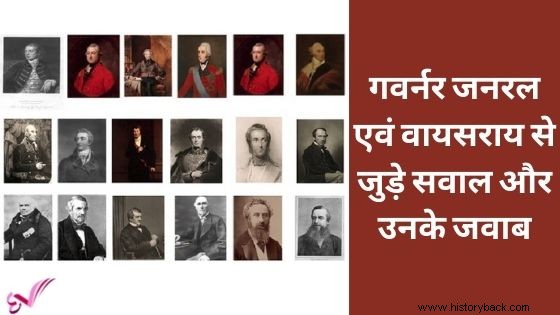Today in this article we are going to tell you about the questions and answers related to Governor General and Viceroy, with the help of which you can prepare for your exam.
Governor General and Viceroy related questions and their answers

Q. When did the British make the British the medium of instruction in India?
Ans. 1835 AD
Q. Who enacted the Indian Universities Act?
Ans. Lord Curzon
Q. During whose Viceroy period India became independent?
Ans. Mountbatten
Q. Who first proposed the idea of forming a federation?
Ans. Nehru Report, 19
Q. Which charter act ended the trade monopoly of the East India Company with China?
Ans. Charter Act, 1833
Q. What was Pitt's India Act, 1784?
Ans. Regulatory Act
Q. In which direction was the Peshwa system abolished by the British?
Ans. Bajirao
Q. Which incident did not happen during Lord Curzon's business?
Ans. Formation of Indian National Congress
Q. By whom was the fresh revenue settlement of Bengal started?
Ans. Cornwallis
Q. Who was the first Governor General of independent India?
Ans. Lord Mountbatten
Q. In which year was the Constituent Assembly established to frame the Constitution for India?
Ans. 1946
Q. Who was established under Pitts India Act?
Ans. Control Board
Q. The person who introduced the concept of Dushasan in the year 1919 Act?
Ans. Mountague
Q. By whom was the system of communal constituencies started in India?
Ans. Minto Marley Reforms of 1909 AD
Q. Who was the first Viceroy of India?
Ans. Lord Canning
Q. Who is generally considered the pioneer of local self-government in modern India?
Ans. Ripon
Q. Which Governor General of India was impeached by England?
Ans. Warren Hastings
Q. Which Governor General's name is associated with the state grab policy?
Ans. Lord Dalhousie
Q. For what purpose did the British start railways in India?
Ans. To facilitate British commerce and administrative control
Q. The important feature of which act was provincial autonomy?
Ans. Year 1935
Q. From which place was the rail journey started in India for the first time in 1853?
Ans. Mumbai
Q. Who was the last Governor General of India?
Ans. C Rajagopalachari
Q. Who made it possible for Indians to enter the Indian Civil Service through an open competitive examination?
Ans. Dalhousie
Q. Which governor welcomed Ranjit Singh with great respect?Ans.
Ans. William Bentinck
Q. Who was the first Indian Governor General of India?
Ans. C Rajagopalachari
Q. The transfer of government from the Company to the Emperor was announced by Lord Canning on November 1, 1858?
Ans. In Allahabad
Q. Which can be considered the most useful and important reform of Lord Curzon, especially with respect to the people living in the undivided Punjab province?
Ans. Agricultural Reforms
Q. Which governor started civil services for the first time in India?
Ans. Lord Cornwallis
Q. State kidnapping policy was first implemented on which Indian?
Ans. Satara
Q. Who is the British Governor General, who introduced postage stamps in India?
Ans. Lord Dalhousie
Q. The first telegraph line started by Lord Dalhousie in 1853 AD was between whom?
Ans. Kolkata and Agra
Q. During the tenure of which governor the Indian National Congress was formed?
Ans. Lord Dufferin
Q. The first Indian ruler to accept the treaty proposed by Lord Wellesley in 1798 AD was
Ans. Nizam Hyderabad
Q. Which British Viceroy is associated with the partition of Bengal?
Ans. Lord Curzon
Q. According to which the Constituent Assembly of India was constituted?
Ans. Cabinet Mandal Scheme (Cabinet Mission Plan)
Q. Who was the first Governor General of East India Company in India?
Ans. Warren Hastings
Q. Through what means was an attempt to incorporate representative and popular narrative into the governance system of India for the first time?
Ans. Indian Councils Act of 1892
Q. When and which Governor General took the decision to make English the medium of instruction in India?
Ans. 1845- Lord Harding
Q. By which act the British government was given the authority to imprison any person in the court of law without trial and conviction?
Ans. Rowlatt Act of 1919
Q. The Marley-Minto Reforms of the year 1919 are famous for what?
Ans. Separate electorate
Q. During the reign of which Viceroy the first Udyog Sala Act was passed?
Ans. Lord Ripon
Today in this article we have given you questions and answers related to Governor General and Viceroy, vaaysraay, sabse pahle vaaysraay koun the, sabse aakhiri vaaysraay koun the, free india vaaysraay koun If you want any other information related to this, then you can ask by commenting in the comment box.
